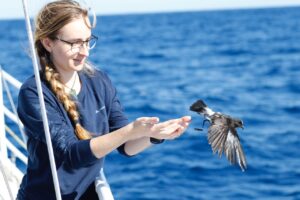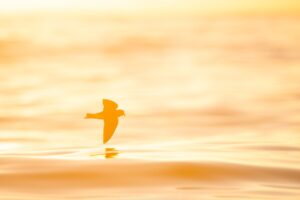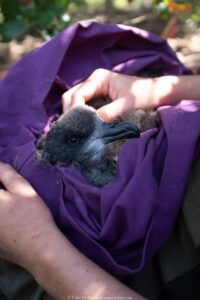As EAAFP is designating 2022 the “Year of the Terns,” we are bringing great work and stories on tern conservation to you. The next story is from Ms. Edin Whitehead, who is a seabird scientist and conservation photographer in Aotearoa New Zealand. She was also a judge of the Year of the Terns Photo Contest (link).

Photo of her releasing a New Zealand storm petrel @Jochen Zaeschmar
EAAFP: Hello Edin, first of all, thank you once again for your effort as a judge to the Year of the Terns Photo Contest. Before we go deep, could you please tell us a little bit about yourself and your background? What brought you to studying seabirds and become a conservation photographer?
Two things have always been constant in my life - a love of the outside world, particularly birds, and a love of creating. I started out sketching and painting, and eventually started joining my Dad on birdwatching trips that have morphed into bird photography trips over the years. It’s something we both love to do. I actually started studying Fine Art at university before switching to biology – so I could go on field trips around Aotearoa! I fell in love with seabirds – particularly petrels and albatrosses – after going to sea for the first time. The science and photography parts of my life have just started to combine into a career, and I value being able to use my photographs to share seabird science stories, and advocate for their conservation.
EAAFP: We heard that you have recently released a book, Brilliance of Birds. Could you please introduce it to our audience and are there any highlights you would like to share?
The Brilliance of Birds was published in 2019 by Penguin Random House New Zealand. It was a collaborative project between me and Skye Wishart, and we like to call it a bit of a celebration of some of the unique bird species that call Aotearoa home. There’s a mix of native and endemic species, as well as some of the introduced ones that people see every day, and we tell stories about their behaviours and biology, as well as their histories and cultural importance. I had so much fun working on the photographs for that book – I spent a year travelling around the country on ‘birdventures’ to meet species I’d never seen before. One of my most special memories from that time was photographing tarapirohe – Black-fronted terns – in the early spring snow in the Eglinton Valley in Fiordland.
EAAFP: We found that you have also prepared a report on “Threats to Seabirds of Northern Aotearoa New Zealand” could you share with us the background on why this report was prepared and the processes behind it? Additionally, do you have any key messages from the report you would like to share?
Seabirds are the most threatened group of birds in the world, and for well-targeted local conservation management, it’s important to understand which threats are most impacting the birds in your region. The report was put together to collate all the information we had for seabirds in the Northern Aotearoa region, and highlight the knowledge gaps about seabird biology and threats to seabirds that needed to be filled. It has since spurred a number of research projects, which is great. I think one of the key messages from the report was that we need to consider the whole ecosystem when doing conservation management – there’s no point in trying to restore seabird populations on land by controlling predator species if there’s no food in the marine habitat to sustain them.
EAAFP: What was the most memorable moment during your expeditions?
That’s a difficult question! One of my favourite research expeditions in the past few years was volunteering on a project catching New Zealand storm petrel at sea for a genomics study – to understand if there might be hidden populations on different islands. At the moment, Te Hauturu-o-Toi (Little Barrier Island) is the only place they’re known to breed. Capturing these tiny birds at sea is really tricky! It was hard work, and we would work into the evening if the conditions were calm enough. One evening the sea was like a mirror, and being out in the dinghy to catch the birds was like floating inside a huge prism of pinks and purples, with these tiny black-and-white birds dipping along the surface. There were a few Antipodean albatrosses cruising past as well. I took lots of photographs, but none of them really do justice to how beautiful it was. We caught one last bird just after the sun had set.

Storm petrel at sea @Edin Whitehead
EAAFP: On your webpage it says you “combine science and storytelling to help people explore our natural world” could you share with us an example of one of these stories?
One of my long-term projects is to illustrate and share the lives of the seabirds that live around northern Aotearoa – particularly in Tīkapa Moana, the Hauraki Gulf. There are 27 species of seabirds that breed here, and many of them are species that people will never see unless they go out on the water, sometimes quite far offshore. I want to share the wonder I have in this remarkable diversity, and get people excited about these birds – most people don’t even know that there is a species here that has come back from being thought extinct for over 100 years – the New Zealand storm petrel. I’ve been really lucky to be involved in some of the research on this beautiful little bird, so I get to share some of the behind-the-scenes of seabird science. It’s a topic I often speak on, and I even work it into my photography talks!
EAAFP: As a conservation photographer, are there any tips or words of caution you would like to share with other photographers?
I think in a world where photography seems to have morphed into a ‘content-creation’ craze on social media where people do anything for ‘likes’, it’s really important to look at what value your photography gives back to the ecosystems that you work in. Ethical wildlife photography, honesty in captioning, and advocating for conservation are all crucial to this.
EAAFP: Seeing your online gallery, we see many photos of albatrosses, are they your favorite Seabird Species? Could you share about your favorite seabird?
I do love albatrosses and petrels! Their lives fascinate me – how they live far out on the ocean and make huge migrations around the world. I find it hard to say I have one favourite species, but I do have a soft spot for tiny little storm petrels – like the New Zealand storm petrel or White-faced storm petrel. They live in the same wild seas that albatrosses do, but they’re so much smaller and I find their resilience truly remarkable.
EAAFP: Lastly, we know you wear many hats as a Doctoral Candidate at the University of Auckland, a conservation photographer, a blogger, an explorer in expeditions and more. How do you balance everything?
There is a lot of overlap! I spend time on my own research trips making photographs that I use to communicate conservation issues. Sometimes I do have to prioritise what is most important – my blog has fallen a bit quiet as I work on writing up my thesis at the moment.

Grey-faced petrel in purple bag @ Chris Gaskin





